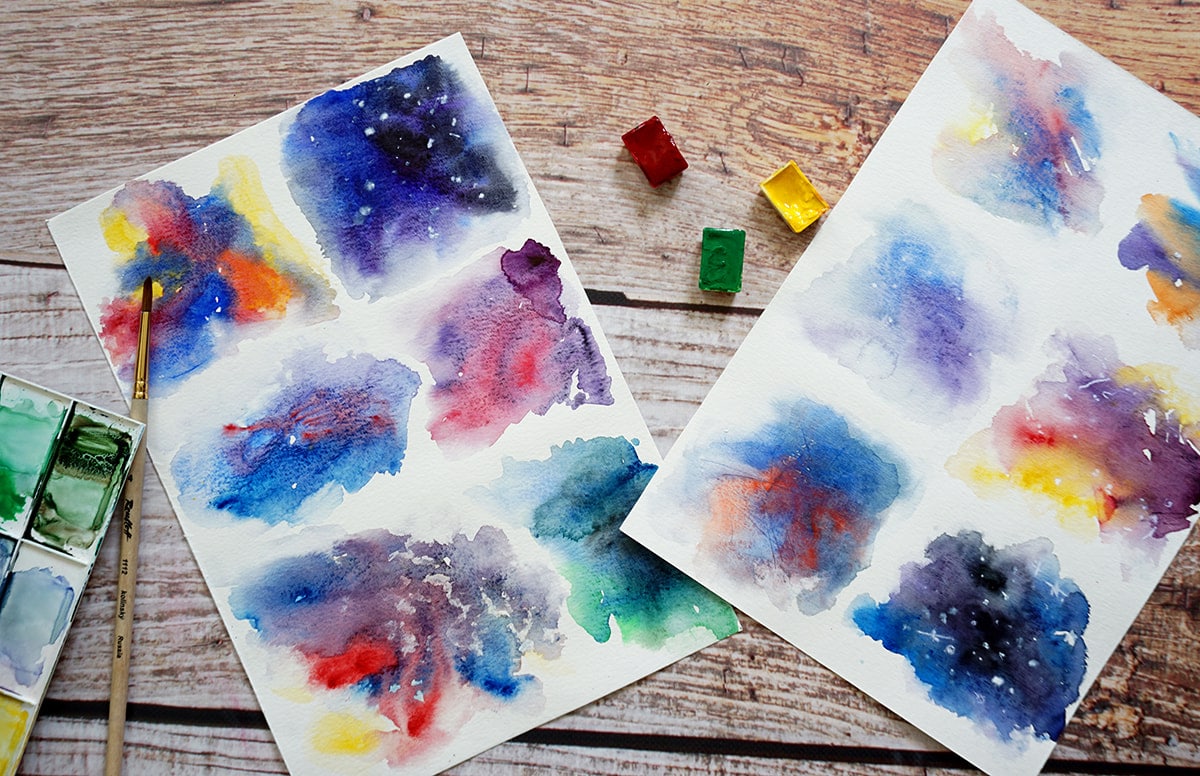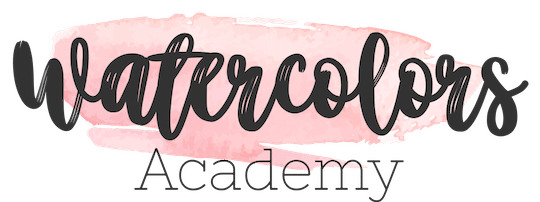“Watercolor is unforgiving!”, “Watercolor is too fluid and goes everywhere!”, “It got too muddy or too light, not what I’ve planned it to be!” So, is watercolor painting difficult?
Have you ever had those thoughts?
Well, pretty much everyone who tried watercolor had. And it’s Ok.
I mean, is there anyone who has tried to learn to ride a bicycle without falling at least once?
I will try to help you get back up and keep going through your watercolor journey because watercolor is amazing and worth the ride!
I have been teaching live workshops around the world for a while now and had to explain watercolor basics to people of different age, nationality and character.
So trust me, I’ve answered this immortal question many times.
Watercolor is indeed challenging, but it IS possible to master it, and You can do it.
You just need a little guidance and understanding of how this particular medium operates.
Below I list most common watercolor fears and solutions to them, so that you know what to do and feel more encouraged.
Watercolor is a water based medium.
It’s the first and main crucial difference from all other media.
That means the magic will happen if there is enough water.
One of the biggest problems my beginner students encountered was picking up too thick pigment on a brush which made the painting look more like gouache.
They were afraid of watery splashes and lack of control so they would get as much pigment as possible and laid it down on paper with a thick layer.
Hell yeah you control it then!
The beauty of watercolor is all those transparent layers and overall airy feeling of an artwork.

Creation by canotstoppainting
Solution
Allow yourself to let go!
It’s really is in our head.
Take a cheap paper sheet (for this exercise paper qualities don’t matter, so no need professional paper), drop clean water on it, then dip your brush into diluted paint (check there are no pieces of pigment hanging on your brush) and put it on that water drop.
The two will mix and flow.
Just observe.
Then add another color (also with a wet brush and watery pigment on it).
The colors will mix and flow in a beautiful way.
You can lift the paper and rotate it to see how paint “runs” in different directions.
You can even take a straw and blow in it towards the paint – it will explode and create original patterns.
Important that you don’t think of this paper as a “wasted material”.
Take as much time and paper as needed, because it has to be done for you to let go of fear.
Thus it’s an investment into your skills and progress! It’s the purpose of that paper!
The thickness and brightness vs transparency of the layer depends on the ratio pigment vs water.
The more water you add to paint, the more diluted it becomes.
It also depends on the brush you are using: natural brush absorbs more water than synthetic so mixing feels different.
Take synthetic brush, squeeze pigment from a tube, smudge it on palette and add one drop of water.
Check how bright and concentrated the stoke will look on paper.
Then do the same but add 2-3 drops of water. The more drops of water you add to the paint the lighter your stroke will look.
If you work with pans, you can lift the paint from it with a very wet brush (literally dripping water from it) first, make a stroke and see the result.
Then try to drop 1-2 drops of water directly on the pan, load the brush with that paint and make a stroke.
Test all ratio-variations, maybe use a little sketchbook to write down the results as a reminder for yourself.
Pick a simple image (for example a poppy flower) and paint it twice: with lots of water and just enough water for brush to actually lay paint.
Train your hand to feel how much water you need to take to achieve the result you need.
If you are really into controlling pigment and want to work mostly with illustrations, there is a solution for you: glazing technique.
That means you create a painting layer by layer with a time-break to let the paint dry after each layer. This requires patience but it guarantees you every stroke in a “right” place.
Final advice
When the paint goes “the wrong way” look at it creatively – how can you use that for your benefit?
What can you add to make it look like it was supposed to be there in the first place?
Noone will ever know that the paint went the wrong direction unless you tell them ?
Fear #2. Cannot achieve transparency
Translucent look is a signature quality of watercolor, no questions asked.
Even though it is natural to most of pigments, they are still divided into transparent, semi-transparent, and opaque.
You can see these qualities marked on the tube or look them up on a color chart on the brand website.
That means if a manufacturer created a certain pigment as opaque – it will be hard to achieve translucency no matter how hard you try.
Besides the color might look the same but have completely different qualities.
Take for instance yellow color with PY40 (pigment yellow 40): Aureolione 559 (PY40) from Sennelier is transparent and Cobalt Yellow W628 (PY40) from Mijello is semi-transparent and leaning towards opaque.
This can also be true with colors within one brand line.

Solution
Remember the students I mentioned earlier?
After a third person in a row picked a massive chunk of pigment on a brush, I decided to create a special exercise for them to train transparency:
draw a circle (or any shape) with a pencil, then draw another circle inside it. Now take your paint and try to color the circle in the way that you can still see the circle inside.
Can you see it?
Congratulations, you created a transparent layer!
Now do the same but draw the shape inside the main circle with less pressure on a pencil, which means the lines are gonna be lighter, less visible.
Now try to paint to cover that circle and keep those lines visible.
That’s a great practice to train your hand and eye.
You can have fun and, for example, create simple flowers (built of circles and ovals) where each petal has multiple circles inside!
Test your own paints for opacity and transparency.
It is pretty easy to do: create a grid where you will locate each color, draw a pencil line inside each section, then apply paint you a testing in a section but start with a super thick stroke extending the paint all the way down your section until the layer becomes transparent.
You will get a gradated wash covering the pencil line.
Now you just need to wait till it gets dry and see if the pencil is still visible under the layer of your paint.
Learn your own paints to know which one to take when painting a super transparent artwork!
Fear #3. I get dirty (muddy) colors
Sometimes we get so excited about layering and creating all those shadows that in the end the painting looks like a muddy burst of colors.
This happens from not knowing the color mixing rules.
Good news: it is simple and you can learn them!
The problem is solved.

Solution
Understand how color wheel works.
It will help you find the best match for any color you use to create a harmonious wash.
To simplify: the opposite color to any given color is called “complementary”, and they will always look good together or in a mix.
So if you are not sure how to make a color darker and keep it clean, just look up what color is on the opposite side of the color wheel and take it.
There are other ways but it’s a topic for another article ?
Make your own test of different combinations.
Write them down in a sketchbook with a color sample and name of pigment.
Make sure to use the pigment terminology instead of a marketing name (PB 29 instead of “ultramarine”) since every brand have different ways of “cooking” the paint and pretty names can be the same but have different pigment inside the tube.
Often you will hear an opinion that muddy wash is a result of mixing paints which has more than 1 pigment each.
So let’s say if you want to create green color by mixing yellow and blue, and you take: yellow color named “Quinacridone Gold” (from Winsor & Newton) which consists of PR206, PV19, PY150 and blue color named “Mountain Blue” (from Schmincke) which consists of PW5, PB29, PG7, what you get in the end is not just green color, but something that has 6 pigments mixed all together.
So yeah it might look pretty muddy ? It is important to take a look behind the scenes and pay attention to the pigment composition to avoid pigment cluster in a situation where things must be simple.
Nevertheless this is not always true and there are many examples of combining paints with multiple pigments inside and receiving a nice and clean color.
But that’s another long story worth a separate publication.
Fear #4. I can’t fix mistakes
Yeah, that’s a trade off: you get a light and translucent artwork in exchange for no permission for a mistake.
Transparency makes it hard to cover a mistake and paint over, stainy features don’t allow to erase it.
I feel your pain: I myself was in situations when I’d spent hours to work on a portrait and then an unfortunate mistake on the secondary part (like clothes) would ruin the whole painting. Luckily, there are still ways to save your work!

Solution
Water is your friend.
Yes, I am still talking about watercolor, and in a case of fixing mistakes water is exactly what you need!
Try to make a stroke with a dry brush and lift it with a tissue.
And now pick the paint with lots of water on your brush, make a stroke and lift the paint with a tissue.
You will notice that the more water you have in your strokes the easier it is to lift the paint from the paper.
This way you can insure yourself by always using lots of water in your washes and keeping a clean tissue on guard in another hand.
You can even drop some extra clean water on that area you want to erase and lift it all together.
There are exceptions: stainy pigment.
This is a special quality of some watercolor pigment which have the ability to penetrate paper layers and stay there no matter how hard you try to lift it with tissue and water.
Most of brands mark stainy qualities of their pigments but it is always best to do your own test to make sure which pigments are friendly for erasing from paper surface and which are not.
Fear #5. What do I do with black and white paint?
Beginners are often told to throw away black paint when starting with watercolor and never touch the white one.
That’s not because a grumpy teacher wants to make your life harder by limiting your paint choice, the truth is…you Can use black and white paint.
But if you truly want to master watercolor medium you need to understand how to mix colors by yourself and how they behave in certain situations.
If you take the easier path you will end up covering half of the painting with just pure black paint which in itself is a pretty flat color.
It doesn’t have depth in it nor tonal variations.
Only when you learn how to create black color without using black pigment you will feel free to “break the rules” and use black pigment the way you want in your art.
More than that, there are tons of artists who use plain black pigment straight from the tube.
But they do it not because they need “darker tone” but because they want to make an accent, point the detail out.
What I am trying to say, they use black not out of choice and not cause it’s easy, but with a purpose. Shadows are much more complicated than just a diluted black paint.
Same goes with white: if you want to create white highlights or show the highlighted side of an object you should leave that place blank and let the whiteness of the paper do the work.
Nevertheless, a lot of artists mix white pigment with other colors to make their mix more calm, mute, and overall matte.

Solution
First, learn how to mix your own black color.
The easiest way is to take your darkest pigments (like mars brown, sepia, indigo, violet) in their thickest condition and mix the darkest tone.
This will give you a result with diverse tones and subtones which is already more interesting than just a plain black color.
Use black in places where it’s logical and necessary but not because you feel lazy to mix your grey tone with three primaries.
Don’t be afraid of white paper: better to leave it clean and fill in later (if needed) rather than paint it and regret (because you can’t make the paint layer lighter, only darker).
Here you need to be a little strategic and plan ahead what areas of your image must stay purely white.
If you stress out about it, thankfully brands invented masking liquid. Use it to cover the area you need to preserve and relax.
Fear #6. Can’t predict the final result
Well…if you really think about it, is that a problem?
It’s rather an exciting and fun part of not knowing and being pleasantly surprised with the final result ? When I just started painting I was always trying to copy every single tiny detail of my reference photo and got upset that the colors were not ideal.
At that time I thought “better copy – better art”.
And of course not always your final painting turns out exactly the way it looked in your head.
But guess what, being an artist is not being a copy machine, you are allowed (and more than that – welcomed!) to improvise, follow the flow and Create!
Don’t let your expectations become your own prison, enjoy the Process of painting instead of waiting for perfect result, and then your final piece will come as a cherry on top.
Your painting is you artistic view of the world, no one can tell you how you should see it.

Solution
Relax and don’t paint for the sake of the result.
Paint for the sake of the process.
Then any result will come as a satisfying piece: you’ve got an experience, you became better because you were practicing and you created something beautiful.
Watercolor has the tendency to become lighter in tone after it is fully dry.
Some are more pronounced than the others.
Take the time to test and note the change: how bright the layer is when wet and how much tone is looses when dry.
To keep the memory long, take a photo of both states.
Additionally some paper has the tendency to “absorb” the color.
For example, Arches can “consume” 30-40% of the paint brightness.
That can be confusing when you apply a nice deep layer and after 20 minutes this layer gets pale.
The only way to know what to expect is to test different paper, pick the one you like the most and stick to it.
Conclusion
I tried to keep it short but…oh well.
Watercolor is definitely not a medium you learn overnight.
If you are looking for a simple hobby to keep yourself busy without putting much effort into, then maybe aquarelle art is not for you.
On the other hand, all the fears and problems students have with it can be easily fixed.
People feel watercolor is difficult because they are trying to paint without understanding the rules and foundations of this material.
You won’t drive too far without knowing how a car works.
There is no luck or magic, just practice and learn your own art tools.
The better you know the paint and paper you’re using the easier it would be for you to predict the behaviour of both.
Also all the fears vanish after you spend some time learning the basics of watercolor: color mixing rules, main features, main techniques.
Equipped with knowledge and practice painting with watercolor will become only fun, enjoyable and easy!




Fantastic thank you!! Im very inspired!
very happy you find it inspiring! 🙂
Love your message here and love the information! I am a beginner and this is really clear, enlightening and reassuring. …….And all of it is accompanied by lovely upbeat guitar, which I am partial to. Can you tell me the name of the guitarist you’re using for the background music?
thanks! Really happy you enjoyed this post! As for music, unfortunately I don’t remember the name of the artist, but I like guitar bits by Checkie Brown 🙂